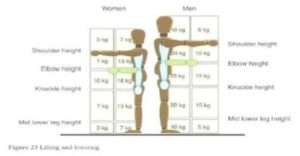This Guidance Note gives practical information about reducing the risk from manual handling.
Manual handling injuries account for over a third of all accidents reported to the enforcing authorities each year.
Sample documents are included in Appendix 1 and Appendix 2. If you wish to use these templates to construct your own documents, you must ensure that all references to Alcumus SafeContractor Accreditation have been removed and the final documents are clearly incorporated into your existing safety management system.
Under the Manual Handling Operations Regulations 1992 (as amended) the employer has legal duties to:
This assessment is necessary to ensure that employees do not suffer injuries from manual handling tasks and it is important to note that there is no maximum weight given for manual handling tasks.
Most of the assessments can be done in house and will just require a few minutes’ observation to identify ways to make the activity less hazardous, i.e. less physically demanding.
When making these observations employees should be consulted, as more often than not they are aware of what the problems are and the easiest ways of avoiding them. The overall responsibility for suitable assessments remains with the employer.
A general assessment of risk, (as required by Regulation 3(1) of the Management of Health and Safety at Work Regulations 1999) may indicate the possibility of injury from manual handling operations. In these circumstances a more specific assessment should be carried out. How detailed this further assessment needs to be will depend on the circumstances. In general, the significant findings of the assessment should be recorded and the record kept, readily accessible, as long as it remains relevant.
Assessments need not be recorded if:
When making a more detailed assessment the following categories should be considered:
(These can be easily remembered by the acronym TILE).
A simple checklist to assist with the detailed assessment is attached at the end of this guidance note. You will also find a template of a manual handling assessment form.
There is no such thing as a totally risk free manual handling operation. The Health and Safety Executive have produced a risk assessment filter which states that remaining within the guidelines may remove the need for a detailed risk assessment.
The guideline figures given below should not be regarded as “safe” weight limits for lifting, as there is no threshold below which manual handling operations may be regarded as ‘safe’. Working within the boundaries of the filter should provide a reasonable level of protection.

(Ref: Manual Handling Operations Regulations 1992 (as amended). Guidance on Regulations ISBN 0717628230, HSE Books).
Each box in the diagram contains a guideline weight for lifting and lowering in that zone. The guideline weights are reduced if handling is done with arms extended, or at high or low levels, as that is where injuries are most likely.
Observe the work activity being assessed and compare it to the diagram.
First decide which box or boxes the lifter’s hands pass through when moving the load.
Then assess the maximum weight being handled. If it is less than the figure given in the box, the operation is within the guidelines.
If the lifter’s hands enter more than one box during the operation, then the smallest weight figure applies. An intermediate weight can be chosen if the hands are close to a boundary between boxes.
The guideline figures for lifting and lowering assume:
If these assumptions are not valid, it will be necessary to make a full assessment.
The basic guideline figures for lifting and lowering in the diagram on the previous page are for relatively infrequent operations – up to approximately 30 operations per hour or one lift every two minutes. The guideline figures will have to be reduced if the operation is repeated more often. As a rough guide:
In many cases manual handling operations will involve some twisting, ie moving the upper body while keeping the feet static. The combination of twisting and lifting and twisting, stooping and lifting are particularly stressful on the back. Where the handling involves twisting and turning then a detailed assessment should normally be made. However, if the operation is:
The guideline figures for lifting and lowering apply to carrying operations where the load is:
A more detailed assessment should be made for all carrying operations if the load is carried over a longer distance without resting or the hands are below knuckle height or above elbow height.
For pushing and pulling operations (whether the load is slid, rolled or supported on wheels) the guideline figures (below) assume the force is applied with the hands, between knuckle and shoulder height. It is also assumed that the distance involved is no more than about 20 m. If these assumptions are not met, a more detailed risk assessment is required.
Force required to stop or start the load
Men 20Kg
Women 15Kg
Sustained force to keep the load in motion
Men 10Kg
Women 7Kg
There is no specific limit to the distance over which the load is pushed or pulled as long as there are adequate opportunities for rest or recovery.
The assessment should be kept up to date. It should be reviewed if new information comes to light or if there has been a change in the manual handling operations.
The assessment may also need to be reviewed if an injury occurs, or an employee becomes more vulnerable to risk due to illness, or the onset of disability or pregnancy.
An employer must also provide training regarding manual handling. This should include manual handling risk factors and how injuries occur, good handling technique, appropriate safe systems of work, use of mechanical aids. Remember that training by itself cannot overcome: